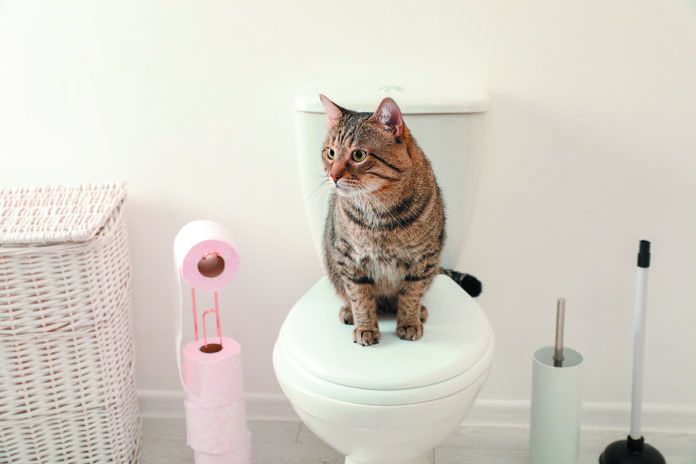Who among us hasn’t seen those cute little videos of cats doing their business in an actual toilet? And who among us hasn’t fantasized about being done with the litter box once and for all, not to mention being done with litter? After all, the bags are heavy, the litter’s powder gets in your face as you go to pour it, and pieces of litter invariably make their way to parts of your home they shouldn’t. As for the box itself, it often takes up too much space or mars the look of a small bathroom or hallway.
Still, for your cat’s sake, stick with the litter. Here’s why.
1. What a cat leaves in the litter box is a good diagnostic tool. Out of habit, you know what your cat’s urine-soaked clumps of litter look like. Much more wet litter than usual could indicate diabetes, hyperthyroidism, a bladder infection, or kidney disease. Much less wet litter could be a sign of a urinary obstruction — which can be life-threatening if not tended to right away.
2. Jumping up onto the toilet seat might be all well and good when your cat is five, six, or seven. But just about all cats develop arthritis over time, with almost half of them suffering pain. What’s your pet going to do once he gets too old to jump up on the toilet seat?
3. Cats like to “bury the evidence.” It’s instinctual for them. In the wild, it helps keep predators off their trail. True, there are no predators in your home (we hope!), but a cat should still have outlets for his natural instincts encoded in his DNA for millenia.
4. You’re supposed to have one more litter box than the number of cats in your home. Even a single cat should have two boxes. Part of the reason for that is that cats are fastidious and want their boxes as clean as possible. But some of them also just don’t like to share “bathrooms.” So if your cat uses the toilet and you want to use the same one, you could potentially run into some territoriality issues, with the cat carving out his own territory for elimi-nating. It may not be a spot you’re happy about sacrificing to “the cause.”
Even if your cat is not territorial, sharing this intimate space with your pet might prove difficult. What if you’re using the toilet when your cat wants to go? Or a visitor has left the seat cover down? Or someone has inadvertently closed the bathroom door? Your cat will most likely find another place to relieve himself. There are plenty of convenient spots — convenient for the cat, that is.
5. You might need to leave your cat at a friend’s house or board him at a facility at some point. Are they going to let him use the toilet?
6. Cats are agile, but even trained tightrope walkers fall sometimes. How happy do you think your cat will be if he falls into the toilet while relieving himself? How happy do you think you will be trying to wash him clean? And what if you’re not home when the fall occurs?
Of course, if your cat teaches himself to use the toilet — some cats do — don’t bother trying to discourage it. But make sure you leave out a litter box, too. Every cat deserves a home with two “bathrooms” and should be familiar with using both of them.





I have 2 cats that taught themselves to use the toilet. I have multiple cat boxes clean and available to them at all times, but they seem to enjoy using the toilet. I never did anything to try to teach them to use the toilet, or did anything to encourage it. And I am still startled when I walk into a bathroom and find them perched on the toilet seat. If I close the lid, they have been known to go into the sink or bathtub and use the drain. So I let them do what apparently makes them happy.
I totally agree with conventional litter pans either open air or hooded. I prefer hooded litter boxes and especially the design with odor absorbing carbon pad/replacement which can be inserted on the top of the cover. Litter managing is one of the ways in noting the health of the furry ones regularly and daily scooping is a pretty easy routine inspection. (Another is noticing their eyes.) Recently a litter robot which resembles our washing machine has started to grab some owners’ attention. I cannot attest the advertising highlights as I have not used it. How to clean and sanitize the litter robot is worrying as there are hidden spaces and corners. Traditional litter pans and boxes have designs which are simple and owners can wipe every corners, every inch holistically. It ensues hygiene which is the best for cats and owners as well.